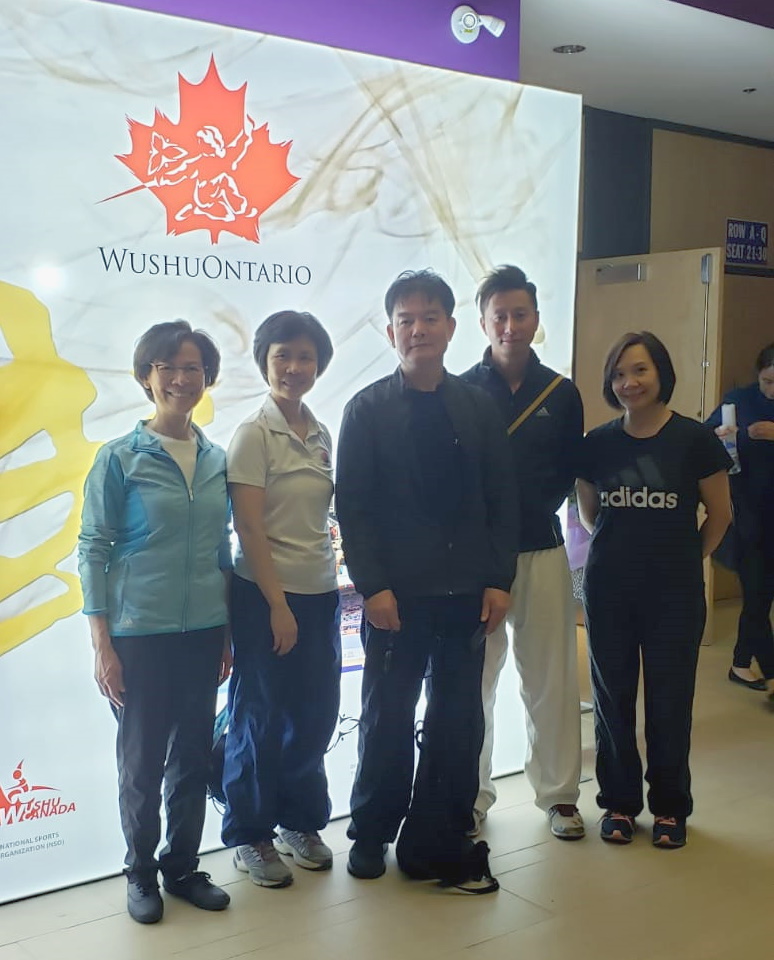
On August 31st 2019, Wushu Canada hosted the Traditional Kung Fu Masters’ Exhibition held in Markham, Ontario. Great Masters from across Canada, United States and China were invited to showcase their martial arts specialty.
The intent of this event was to showcase the many different types of Chinese Martial Arts. Included amongst these different styles of martial arts are:
- Hung Gar
- Choy Li Fut
- Wing Chun
- Tai Chi
- Pak Mei
- Dragon Style
- Lost Track Lorn Han
- Hsing Yi
- Ba Gua
- Praying Mantis
- Luk Hup Ba Fa
- White Crane
and more.

In addition to an invitation to Master Bao Sen Liang and the Ji Hong Tai Chi & Qi Gong school, there were a few other Tai Chi performances showcasing the variety of different Tai Chi styles. From the Ji Hong Tai Chi & Qi Gong School, Master Bao Sen Liang along with four of his instructors Henry Wan, May Rahnema, Aileen Wong, and Helen Lau put together an intricate tai chi performance. The performance showcased the 5 main family styles of Tai Chi:
- Hao Style
- Sun Style
- Chen Style
- Wu Style
- Yang Style
In addition, Master Bao Sen Liang along with Henry Wan injected a side performance of Push Hands which is the interactive application of the tai chi skills in close proximity engagements.
Hao Style Tai Chi
The performance kicked off with Master Liang demonstrating Hao style tai chi. Practised by few people, even in China, Hao is the least popular of the five styles. The Hao style puts a strong emphasis on internal qi. Practitioners learn to focus internally and make significant internal movements to trigger subtle outer movements. From the outside, the movements may look quite similar. From the inside, advanced ability and experience are required to execute the degree of internal control of the dan tian and qi to execute this advanced style of tai chi.
Sun Style Tai Chi
Master Liang is then joined by instructor Henry Wan on stage to demonstrate Sun style tai chi. Sun style tai chi incorporates unique footwork with gentle, flowing and circular hand movements. With its smooth, fluid movements and swift steps, Sun style tai chi mimics a graceful dance. Sun style tai chi is the second least popular of the five styles.
Chen Style Tai Chi
Next, instructor May Rahnema entered the stage to join Master Liang and Henry Wan. Together, the trio performed Chen style tai chi. Chen style tai chi is characterized by slow, graceful spiral movements alternating with quick and powerfully explosive moves. The foundation of Chen style tai chi lies in its low power stances and the generation of spiraling movements which flow from the feet to the hands. Chen style tai chi is the original tai chi style from which all other tai chi styles have emerged. Today, it is the third most actively practiced amongst the five styles of tai chi.
Wu Style Tai Chi
Then, instructor Aileen Wong joins the performance in progress. Together, the four instructors demonstrate Wu style tai chi. Wu style is unique in its emphasis on the extension of the body by leaning forward and backward rather than remaining upright. This characteristic makes it unique from the other styles of tai chi. The back leg serves as a counterbalance, allowing for added extension without losing balance. Wu style is the second most popular style practiced in the world today.
Yang Style Tai Chi
Last but not least, instructor Helen Lau joins the group on stage to perform Yang style tai chi. Yang style is by far the most popular and widely practiced form of tai chi. The Yang family style of tai chi is characterized by its slow, gentle, flowing movements; expanding and contracting the body using large sweeping movements. We encourage new students to learn either this form or the Chen style of tai chi after a semester of acquiring core skills in our introductory tai chi basics class.
Push Hands
As an added treat to the performance, Master Liang and Henry Wan breaks away from the main performance to demonstrate push hands. Push hands is done with two people in constant contact with each other. Each person in the push hands engagement is moving to unbalance the other person. Movements flow continuously as the two partners advance and retreat in sync, matching each other in distance, pace and pressure.
Ji Hong Tai Chi & Qi Gong Schools
It was an enjoyable evening watching all the various kung fu masters perform. The performance by Master Bao Sen Liang with his instructors was especially memorable. We’re proud of our instructors here at Ji Hong Tai Chi and how much these performances demonstrate their depth of skill and proficiency in tai chi.
If you are interested in acquiring this depth of skill in your own tai chi practice, consider joining the Ji Hong Tai Chi & Qi Gong community of practitioners and instructors and expanding your own depth of knowledge with us.


